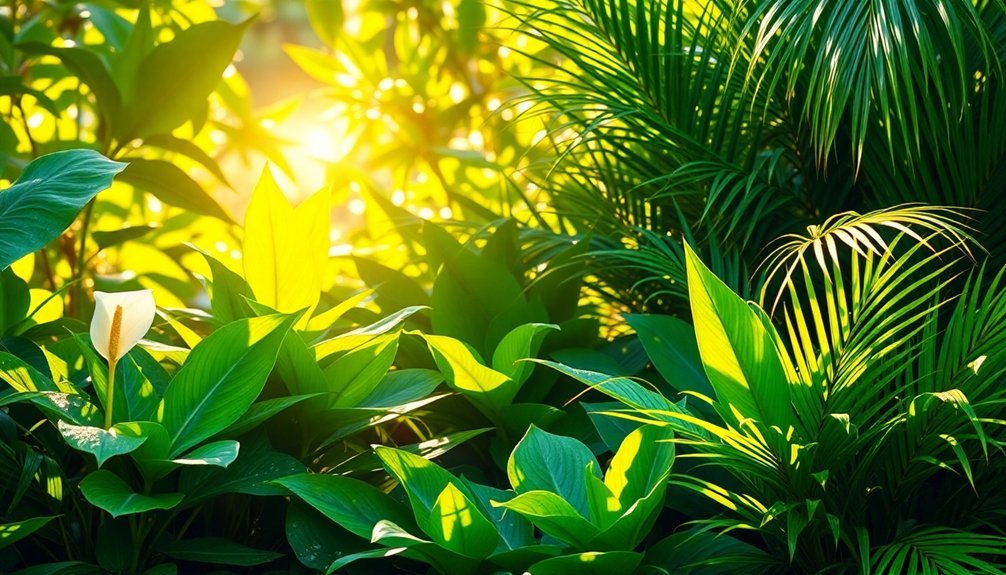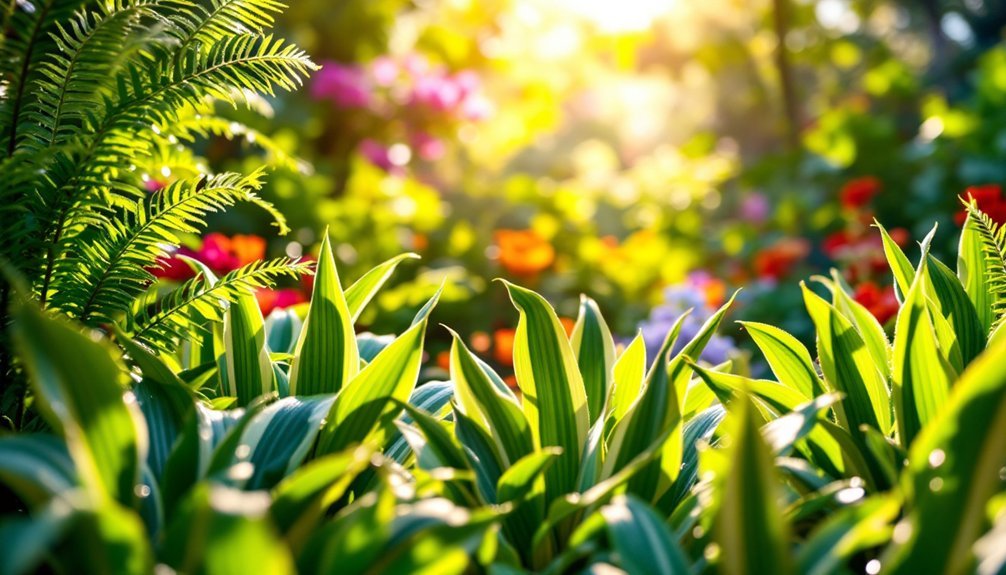Snake Plants, Spider Plants, Peace Lilies, and Boston Ferns are your go-to air-purifying powerhouses for summer. You'll get the most benefit by placing these plants strategically around your home – Snake Plants work great in bedrooms, while Boston Ferns thrive in humid bathrooms. These natural air filters adapt easily to summer conditions and require minimal care. Understanding each plant's specific needs will help you create the perfect indoor air-cleaning ecosystem.
Summer Champions: Top Air-Purifying Plants for Warm Weather

While summer brings warmth and sunshine into our homes, it can also trap indoor pollutants that affect air quality. Fortunately, several air purifying plants serve as summer champions to cleanse your indoor environment.
The Snake Plant stands out by releasing oxygen at night and filtering formaldehyde, requiring minimal care.
You'll love the Spider Plant's easy care nature as it tackles carbon monoxide while producing offspring for propagation.
The Peace Lily thrives in low light conditions, effectively removing various toxins.
Place your Boston Fern in indirect light, where it'll excel at removing pollutants in humid environments.
Each of these plants brings unique air-purifying benefits while adapting well to summer conditions, making them perfect additions to your home's natural filtration system.
Optimal Placement for Maximum Air-Cleaning Effect
To maximize your plants' air-purifying potential, strategic placement plays an essential role in their effectiveness. Position your air-purifying plants in bright, indirect light, particularly Snake Plants and Spider Plants, to enhance their air-cleaning capabilities.
For ideal placement of humidity-loving plants like Boston Ferns and Bamboo Palms, utilize your bathroom or kitchen where moisture levels are higher.
You'll achieve maximum air-cleaning effect by grouping multiple plants together, as this increases the total leaf surface area for filtering indoor pollutants.
Keep Peace Lilies and Chinese Evergreens away from direct sunlight while ensuring adequate airflow around them.
Don't forget to regularly rotate your plants to different spots in your home – this helps them adapt to varying light conditions and maintains their air-purifying efficiency throughout the summer months.
Light Requirements and Summer Care Guidelines

You'll need to carefully balance your air-purifying plants' exposure to summer light, as many thrive in bright indirect light but can suffer leaf damage from direct sun.
Your watering schedule should adapt to the warmer temperatures, with humidity-loving plants like Boston Fern needing more frequent watering and misting to maintain ideal growth.
To prevent heat stress, move sensitive plants like Peace Lily away from hot windows and monitor their soil moisture daily, especially during peak summer hours.
Direct Vs Indirect Light
Understanding proper light exposure is essential for maintaining healthy air-purifying plants during summer months.
You'll need to balance direct sunlight with filtered light to prevent leaf burn while ensuring ideal growth.
Plants like the Barberton Daisy and Flamingo Lily thrive in bright light and require at least four hours of direct sunlight daily.
However, species such as the Peace Lily and Rubber Plant prefer indirect light to avoid damage.
For low-light adaptable plants like the Snake Plant and Chinese Evergreen, you'll still need to provide some filtered light for healthy growth.
While managing light exposure, don't forget to monitor moisture levels.
Plants such as the Boston Fern need high humidity and consistent watering, but be careful not to leave them waterlogged.
Remember that overwatering combined with summer heat can lead to root rot.
Summer Watering Schedules
Managing your air-purifying plants' water intake becomes particularly important during summer months when increased light exposure and heat can quickly dry out soil.
You'll need to regularly check soil moisture levels, but avoid overwatering, as many air-purifying plants prefer their soil to dry between waterings to prevent root rot.
For humidity-loving varieties like Boston Ferns and Bamboo Palms, maintain higher humidity levels by misting or placing them in naturally humid spaces.
While following your summer watering schedules, don't forget to fertilize every four to six weeks, as these plants grow more actively during this season.
To support balanced growth, rotate plants periodically, ensuring they receive even exposure to bright indirect light.
This all-encompassing approach helps your air-purifying plants thrive through the warmer months.
Preventing Heat Stress
As summer temperatures rise, protecting your air-purifying plants from heat stress becomes crucial for their survival and continued air-cleaning effectiveness.
You'll want to monitor your plants regularly and maintain ideal growing conditions to prevent stress-related damage.
- Position your plants in bright indirect light, avoiding harsh direct sunlight that can scorch leaves.
- Maintain proper humidity levels, especially for moisture-loving plants like Boston Ferns and Peace Lilies.
- Check soil moisture frequently, watering when the top inch feels dry.
- Keep plants within their preferred temperature range (15-30°C) by placing them away from AC vents.
- Rotate your plants periodically to guarantee even light exposure and balanced growth.
Balancing Humidity Levels With Plant Selection

You'll find excellent humidity-balancing options for your bathroom in moisture-loving plants like the Bamboo Palm and Boston Fern, which naturally release water vapor into the air.
For dry climate areas, the Lady Palm and Areca Palm serve as champions in maintaining comfortable humidity levels while filtering indoor air toxins.
To maximize these plants' humidity-boosting benefits, try grouping them together and consider placing them in naturally humid spaces like your bathroom or kitchen.
Moisture-Loving Plants For Bathrooms
Transforming your bathroom into a natural oasis starts with selecting the right moisture-loving plants that thrive in humid conditions.
These air-purifying powerhouses not only enhance your space but actively filter pollutants like formaldehyde while managing humidity levels naturally.
Choose from these bathroom-perfect plants that'll flourish in your steamy sanctuary:
- English Ivy excels at reducing airborne particles and mold, making it perfect for bathroom environments.
- Boston Fern thrives on humidity and requires regular misting while filtering harmful pollutants.
- Pothos (Devil's Ivy) adapts easily to various light conditions and loves moisture-rich spaces.
- Bamboo Palm acts as a natural humidifier while removing ammonia and formaldehyde.
- Chinese Evergreen performs well in low light and effectively cleanses the air of multiple toxins.
Dry Climate Plant Champions
Living in arid regions doesn't mean sacrificing the benefits of air-purifying houseplants. You'll find several versatile air purifiers that thrive in dry climates while effectively removing toxins from your indoor spaces.
The Snake Plant and Aloe Vera are perfect choices, needing minimal water to clean the air of formaldehyde and benzene.
For spaces with low levels of light, consider the Rubber Plant or Chinese Evergreen. These hardy plants adapt well to various conditions while combating indoor air pollution.
If you're looking to balance humidity, pair these drought-resistant options with humidity-loving plants like Spider Plants and Boston Ferns. They'll naturally increase moisture levels in your dry environment.
For an extra boost of air purification, add a Bamboo Palm – it's excellent at filtering ammonia while contributing to your home's humidity balance.
Matching Plants to Different Room Functions
Different rooms in your home serve unique purposes, and matching the right air-purifying plants to each space can maximize their benefits while complementing your lifestyle.
The key is selecting indoor plants that thrive in varying light conditions while effectively filtering toxins specific to each area.
- For living rooms, you can't go wrong with Snake Plants and Rubber Plants – they're low-maintenance champions that excel in moderate light.
- Your kitchen will benefit from Spider Plants and Aloe Vera, perfect for bright spaces.
- Transform your bathroom with humidity-loving English Ivy and Boston Ferns.
- Create a peaceful bedroom sanctuary using Peace Lilies and Snake Plants, which release oxygen at night.
- Enhance your workspace with Dracaena Janet Craig and Bamboo Palms, ideal for maintaining focus while purifying the air.
Growth Patterns During Peak Summer Months

As temperatures rise during peak summer months, air-purifying plants enter their most vigorous growth phase, making it the perfect time to maximize their air-cleaning potential.
You'll notice plants like the Peace Lily and Aloe Vera doubling their growth rate, becoming more efficient at filtering pollutants from your indoor environments.
To support this accelerated growth, you'll need to adjust your care routine.
While Snake Plants and Rubber Plants thrive with minimal watering, species like the Bamboo Palm and Boston Fern require frequent watering and higher humidity to maintain moist conditions.
The increased summer sunlight provides ideal light exposure, enhancing photosynthesis in your air-purifying plants.
You'll see particularly impressive results with Boston Ferns and Spider Plants, which capitalize on the season's favorable conditions to boost their air-cleaning capabilities.
Essential Maintenance Tips for Summer Plant Care
While summer brings ideal growing conditions for air-purifying plants, proper maintenance becomes essential for their continued health and effectiveness.
You'll need to adjust your care routine to accommodate the summer heat and increased growth rates. Keep your plants thriving with these key maintenance practices:
- Position your air-purifying plants where they'll receive 4-6 hours of indirect sunlight daily
- Water consistently and maintain moist soil, letting the top inch dry between waterings
- Monitor humidity levels and use misting or humidifiers for moisture-loving varieties
- Fertilize every 4-6 weeks with a balanced houseplant fertilizer to support healthy growth
- Inspect for pests regularly, as warm temperatures can attract unwanted visitors
Following these guidelines will guarantee your indoor air-purifying plants flourish throughout the summer months while maintaining their air-cleaning capabilities.
Frequently Asked Questions
Which House Plant Purifies the Air the Most?
You'll get the most air purification from Spider Plants and Snake Plants, as they remove up to 95% of indoor pollutants within 24 hours. They're your best choice for cleaner indoor air.
Do Air Purifiers Help in Summer?
Yes, you'll find air purifiers especially helpful in summer. They'll remove increased pollen, mold spores, and allergens while filtering out humidity-related pollutants. They also help combat AC-released VOCs for cleaner indoor breathing.
Which Tree Purifies Air the Most?
Among indoor plants, you'll find the Rubber Plant (Ficus elastica) is your best air purifier. It's exceptional at removing formaldehyde and boosting oxygen levels, making it the most effective natural air cleanser.
What Plant Removes the Most Toxins?
You'll find the Spider Plant is your best choice for removing toxins, as it eliminates up to 95% of indoor pollutants within 24 hours, including formaldehyde, benzene, and carbon monoxide.
In Summary
You've got all the tools to create your indoor air-purifying oasis this summer. By selecting the right plants, placing them strategically, and following proper care guidelines, you'll maximize their air-cleaning potential while keeping them healthy. Remember to adjust your plant care routine as temperatures rise, and don't forget to match your green allies with each room's specific needs. Your indoor air quality will thank you.





Leave a Reply